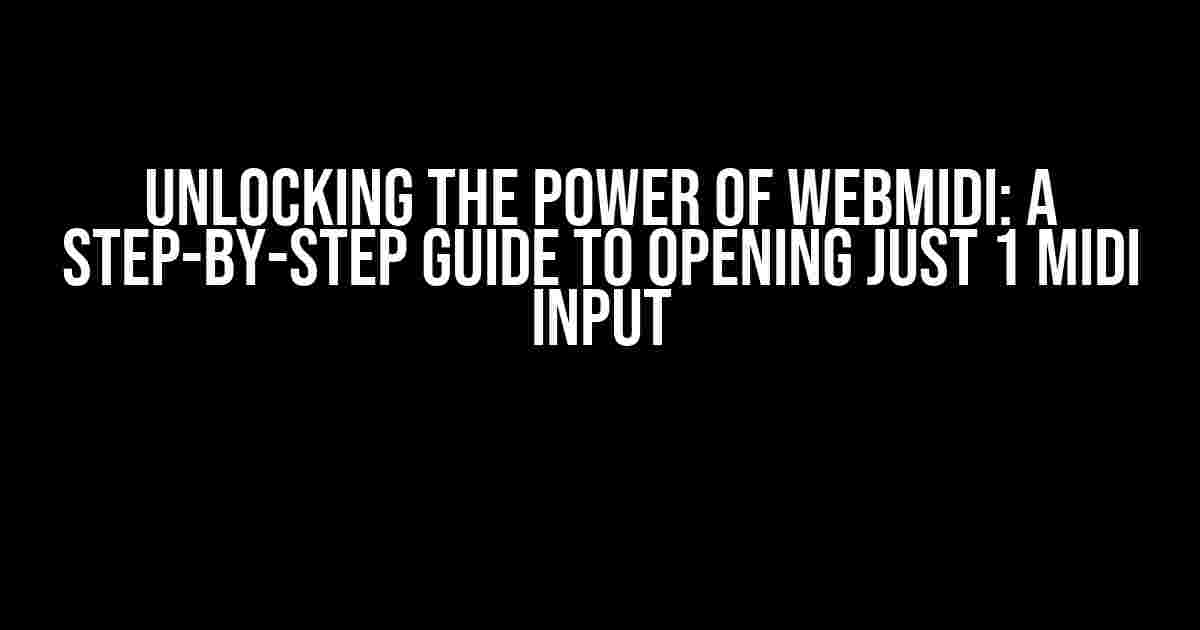Are you tired of dealing with complicated MIDI setups and wanting to simplify your music production workflow? Look no further! In this article, we’ll dive into the world of WebMIDI and explore how to open just 1 MIDI input, giving you more control and flexibility over your music creations.
What is WebMIDI?
WebMIDI is a JavaScript API that allows developers to access MIDI devices connected to a user’s computer or mobile device. It provides a simple and standardized way to interact with MIDI devices, making it easier to create interactive music experiences on the web.
Why Use WebMIDI?
- Cross-platform compatibility: WebMIDI works on multiple platforms, including Windows, macOS, and Linux, as well as mobile devices.
- Easy implementation: With WebMIDI, you don’t need to worry about complex MIDI implementations or proprietary APIs.
- Access to a wide range of devices: WebMIDI supports a vast array of MIDI devices, from keyboards and synthesizers to drum machines and controllers.
Getting Started with WebMIDI
Before we dive into opening just 1 MIDI input, let’s cover the basics of getting started with WebMIDI.
Required Permissions
To use WebMIDI, you need to request permission from the user to access their MIDI devices. You can do this by adding the following code to your HTML file:
<script>
navigator.requestMIDIAccess()
.then(midiAccess => {
// MIDI access granted
})
.catch(error => {
console.error("Error requesting MIDI access:", error);
});
</script>
Accessing MIDI Devices
Once you have permission, you can access MIDI devices using the `midiAccess` object. Let’s create a function to list all available MIDI devices:
<script>
function listMIDIDevices(midiAccess) {
const devices = midiAccess.inputs.values();
for (const device of devices) {
console.log(`Device: ${device.name} (${device.manufacturer})`);
}
}
</script>
Opening Just 1 MIDI Input
Now that we have the basics covered, let’s focus on opening just 1 MIDI input using WebMIDI.
Step 1: Identify the MIDI Device
First, you need to identify the MIDI device you want to open. You can do this by using the `listMIDIDevices` function we created earlier:
<script> listMIDIDevices(midiAccess); </script>
Step 2: Create a MIDI Input
Once you’ve identified the device, you can create a MIDI input object using the `midiAccess.getInput()` method:
<script>
const midiInput = midiAccess.getInput("My MIDI Device");
</script>
Step 3: Open the MIDI Input
Finally, you can open the MIDI input using the `open()` method:
<script>
midiInput.open()
.then(() => {
console.log("MIDI input opened successfully!");
})
.catch(error => {
console.error("Error opening MIDI input:", error);
});
</script>
Handling MIDI Messages
Now that you’ve opened the MIDI input, you can start receiving MIDI messages. To handle these messages, you need to add an event listener to the `midiInput` object:
<script>
midiInput.onmidimessage = (event) => {
const message = event.data;
console.log(`Received MIDI message: ${message}`);
};
</script>
Tips and Tricks
Which MIDI Device to Open?
If you have multiple MIDI devices connected, you might wonder which one to open. You can use the `midiAccess.inputs.values()` method to list all available devices and let the user choose which one to open.
Handling Errors
MIDI devices can be finicky, and errors can occur. Make sure to handle errors gracefully using try-catch blocks and error callbacks.
Optimizing Performance
To optimize performance, consider limiting the number of MIDI messages processed or using web workers to offload computationally intensive tasks.
| MIDI Message Type | Description |
|---|---|
| Note On | Indicates a note is being pressed |
| Note Off | Indicates a note is being released |
| Control Change | Represents a change in a controller’s value |
Conclusion
With these steps and tips, you’re now ready to start using WebMIDI to open just 1 MIDI input and take control of your music production workflow. Remember to explore the official WebMIDI documentation for more information and to stay up-to-date with the latest developments.
Happy coding, and let the music flow!
SEO Keyword: WebMIDI – open just 1 MIDI input
Here are 5 Questions and Answers about “WebMIDI – open just 1 MIDI input” in a creative voice and tone:
Frequently Asked Question
Get the answers to your most pressing WebMIDI questions!
Why do I need to open just one MIDI input in WebMIDI?
Opening just one MIDI input in WebMIDI prevents conflicts between multiple MIDI devices. It ensures that your web app receives input from only one device, avoiding confusion and incorrect data processing.
How do I open just one MIDI input in WebMIDI?
To open just one MIDI input in WebMIDI, use the `requestMIDIAccess()` method and specify the `.sysexEnabled` property as `true`. This will prompt the user to select a single MIDI input device, ensuring that only one device is connected to your web app.
What happens if I don’t open just one MIDI input in WebMIDI?
If you don’t open just one MIDI input in WebMIDI, your web app may receive conflicting data from multiple MIDI devices. This can lead to incorrect data processing, unexpected behavior, or even crashes. So, it’s essential to follow best practices and open just one MIDI input to ensure a smooth user experience.
Can I open multiple MIDI inputs in WebMIDI for different purposes?
While it’s technically possible to open multiple MIDI inputs in WebMIDI, it’s not recommended. Instead, consider using a single MIDI input and implementing logic in your web app to differentiate between different types of MIDI data or devices. This approach keeps things simple and avoids potential conflicts.
How does WebMIDI handle MIDI input conflicts?
WebMIDI is designed to handle MIDI input conflicts gracefully. If multiple MIDI devices are connected, WebMIDI will prompt the user to select a single device. If a conflict occurs due to multiple devices sending data, WebMIDI will ignore the data from all devices except the selected one, ensuring that your web app receives consistent and correct input.
